Altan T. Metal Forming Handbook
Подождите немного. Документ загружается.


–smaller dimensional tolerances,
–consistent dimensions throughout a complete series run, due to
breakthroughs in the cylindrical blanking plate.
Process-related advantages are:
–no blanking shock and the consequent reduction of noise levels and
vibrations,
–fewer production steps in the processing of blanked and combined
blanked/formed parts.
As an example, Fig. 4.7.1illustrates the production of a chain wheel for
a motor cycle using the conventional and fine blanking methods. The
nine work operations required during conventional production, in-
cluding blanking on individual presses and machining through debur-
ring and grinding, can be reduced by using the fine blanking technique
in a complete blanking die to three operations. Fine blanking is also
more advantageous here if we consider the need for time-consuming
and cost-intensive machine changeover using conventional methods.
331
Fine blanking
Fig. 4.7.1 Conventional chain wheel production for a motor cycle (top row):
1. blanking the outside contour; 2. piercing the inside hole; 3. piercing four windows;
4. levelling; 5. turning the inside hole and chamfering on both sides;
6. milling the teeth in the stack; 7. bevel turning of tooth tips on both sides;
8. boring holes and deburring; 9. grinding
Production using fine blanking (bottom row):
1. fine blanking; 2. bevel turning of tooth tips on one side, the second side already
has the die-roll by the fine blanking process; 3. deburring
Metal Forming Handbook / Schuler (c) Springer-Verlag Berlin Heidelberg 1998
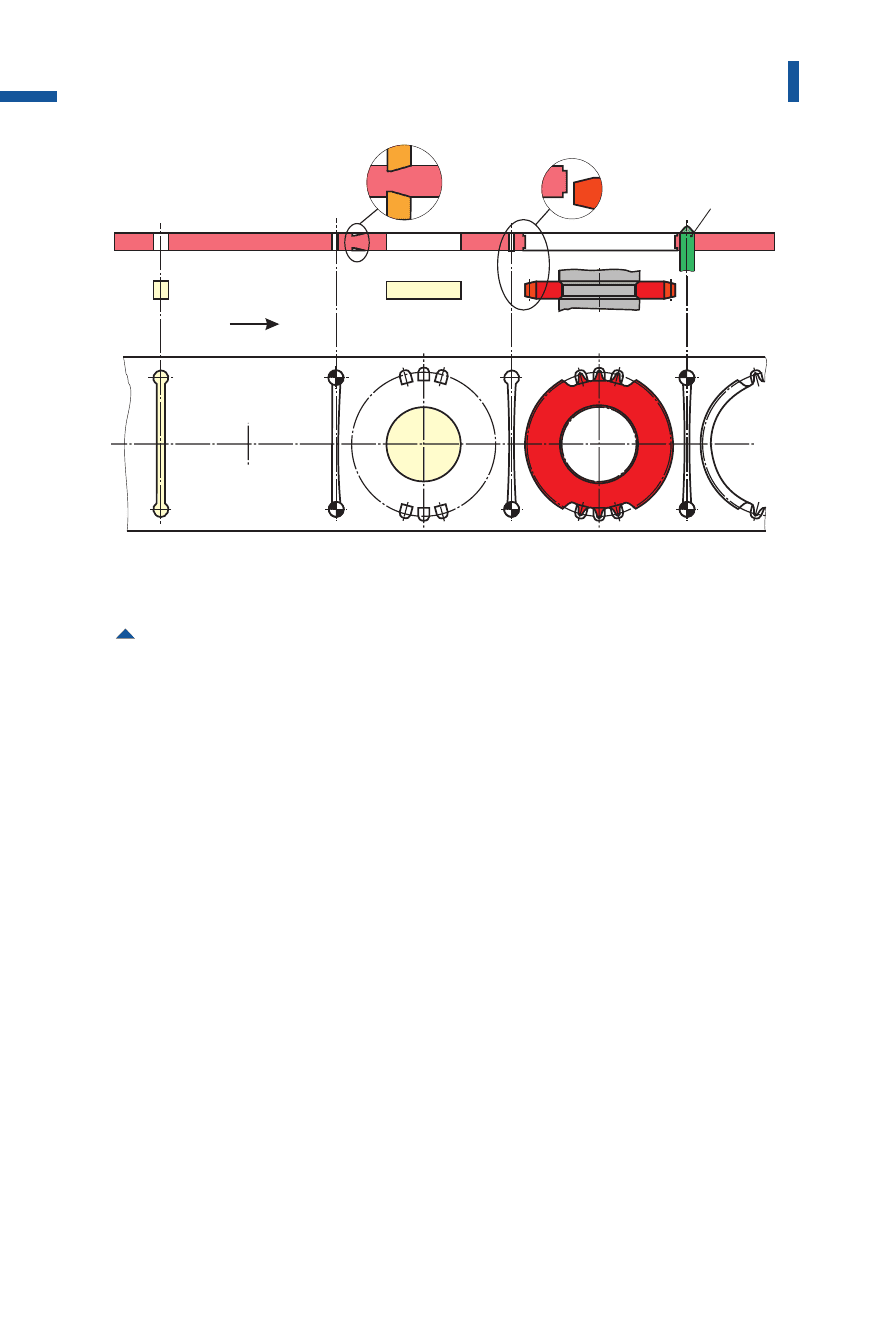
The fine blanking process using compound progressive dies (cf.
Sect. 4.1.1) comprises only three stages (Fig. 4.7.2):
–free blanking with pilot pins,
–embossing the addendum flanks and piercing the center hole,
–cutting out the toothed area and chamfering the center hole.
This method can lead to production cost savings of around 80%
compared to conventional methods.
Die principle
The advantages of fine blanking are based upon differing process para-
meters. During fine blanking, three forces act via the die on the punched
material (Fig. 4.7.3left).Before the start of blanking, a vee-ring is pressed
over the pressure plate outside the blanking line with the vee-ring force
F
R
. Inside the blanking line, the material is pressed by the counterforce
F
G
via the ejector onto the blanking punch. In the clamped status, the
blanking process is carried out by the blanking force F
S
.
332
Sheet metal forming and blanking
Fig. 4.7.2 Strip layout for a three-station compound progressive die when manufacturing
a chain wheel
openblanking
withpilotforms
embossingoftoothhead
bevelsandpunchingof
thecentralhole
cuttingouttheteethand
chamferingthecentralhole
pilotpin
throughfeeddirection
Metal Forming Handbook / Schuler (c) Springer-Verlag Berlin Heidelberg 1998
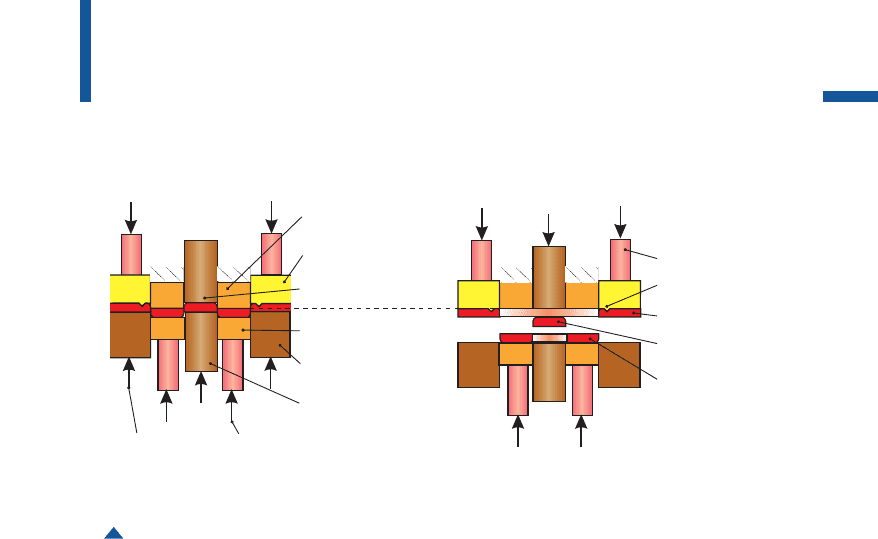
Once the blanking process is completed, the vee-ring force and coun-
terforce are both deactivated, the die opens and after a certain opening
stroke the scrap web and the inner form slugs are stripped off the punch
by the stripping force F
Ra
(Fig.4.7.3 right).The fine blanked workpiece is
ejected from the blanking plate by the ejection force F
Ga
.
Supplementary forces and functions
In fine blanking presses, the slide always works from the bottom
upwards. The slide stroke is divided into a rapid closing, touching, blank-
ing and a rapid return travel (Fig. 4.7.4).
During the blanking process, the vee-ring piston and counterforce pis-
ton are displaced until the completion of the blanking process. During
the return movement of the slide, the part is ejected from out of the
blanking plate by the ejector punch, the inner form slug is stripped by
the ejector pin and both are then removed from the die mounting area
by means of an air jet or removal arm. The coil feed cycle also takes place
during the return movement of the slide. Just before the slide reaches the
bottom dead center, the cropping shear separates the scrap web.
333
Fine blanking
Fig. 4.7.3
left:
Tooling principle of a fine blanking die during blanking
right:
Tooling principle of a fine blanking tool after ejection of the blank, stripping of
the inner form slug and the scrap web
h
f
i
blanking punch
blanking plate
inner form punch
ejector
inner form ejector
vee-ring plate
pressure pin
scrap web
fine blanked part
inner form slug
vee-ring
blanking
force F
S
vee-ring force F
R
stripping force F
Ra
ejection force F
Ga
counter-
force F
G
Metal Forming Handbook / Schuler (c) Springer-Verlag Berlin Heidelberg 1998
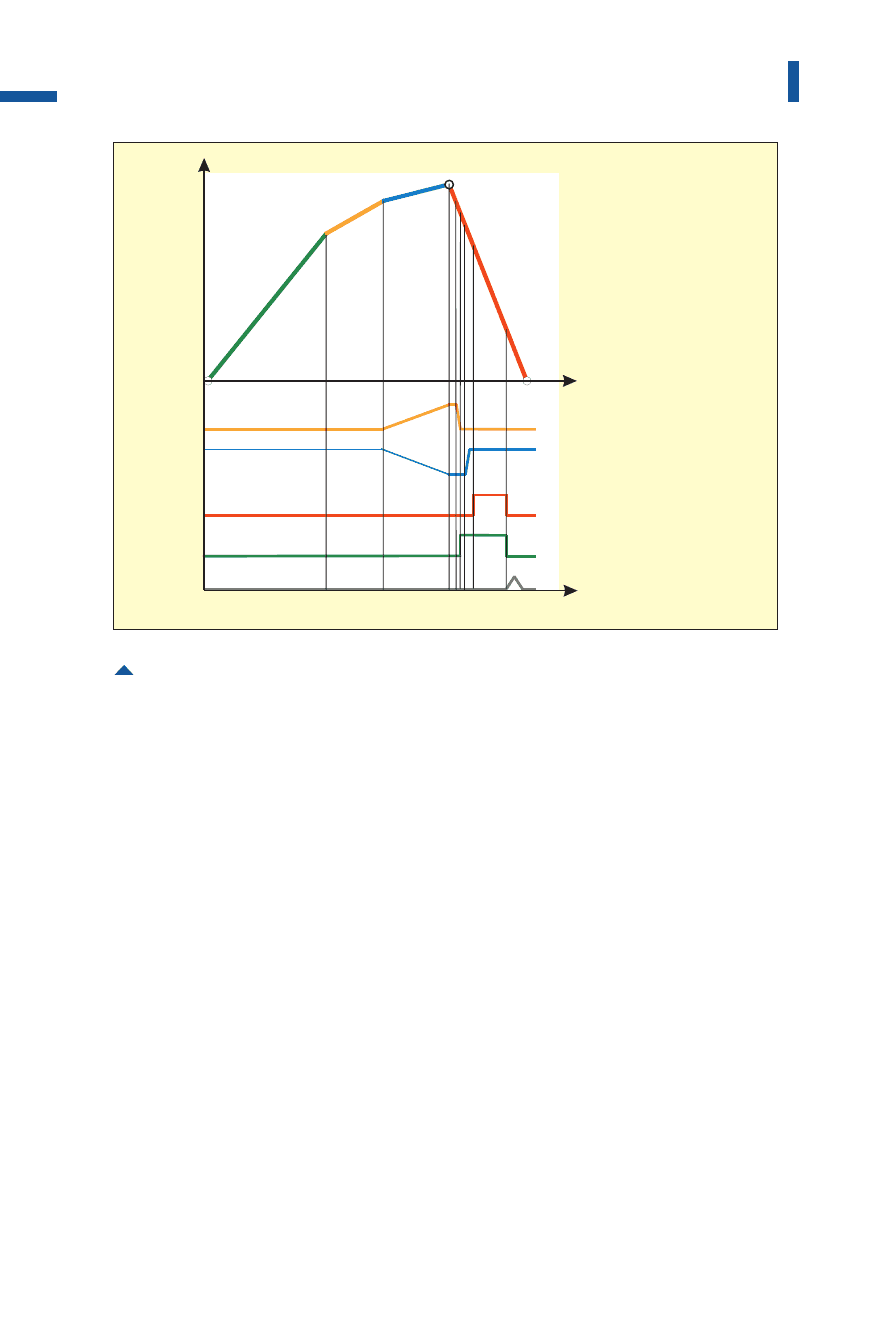
Blanking force-stroke diagram
Figure 4.7.5compares the variation of the blanking force over the slide
stroke or the time required for normal blanking to that required for fine
blanking. During normal blanking, the sheet metal is initially elastical-
ly deformed on impact of the blanking punch (I) and then cut (II). In
phase III, the part tears through, and in phase IV the system vibrations
in the machine and die decay in all three directions(cf. Fig. 4.5.1).This
is the phase in which the greatest die wear takes place. During fine
blanking, the tearing and the vibration phases are eliminated. The spe-
cial process parameters involved in fine blanking prevent the sudden
breakthrough of the part, ensuring a smooth cut over the entire sheet
metal thickness.
Blanking clearance
The blanking clearance is the dimensional difference or gap between
the blanking punch and the blanking die measured on a single side.
334
Sheet metal forming and blanking
Fig. 4.7.4 Supplementary forces and functions during the slide stroke
rapid closing stroke
tracing stroke
blanking stroke
rapid return travel stroke
movement sequence
vee-ring piston
movement sequence
counterforce piston
cycle for removal/air jet
ejection of parts and scrap
feed cycle of the punched
material
scrap seperator cycle
slide
stroke
[mm]
BDC BDC
TDC
time [s]
time [s]
supple-
mentary
functions
Metal Forming Handbook / Schuler (c) Springer-Verlag Berlin Heidelberg 1998
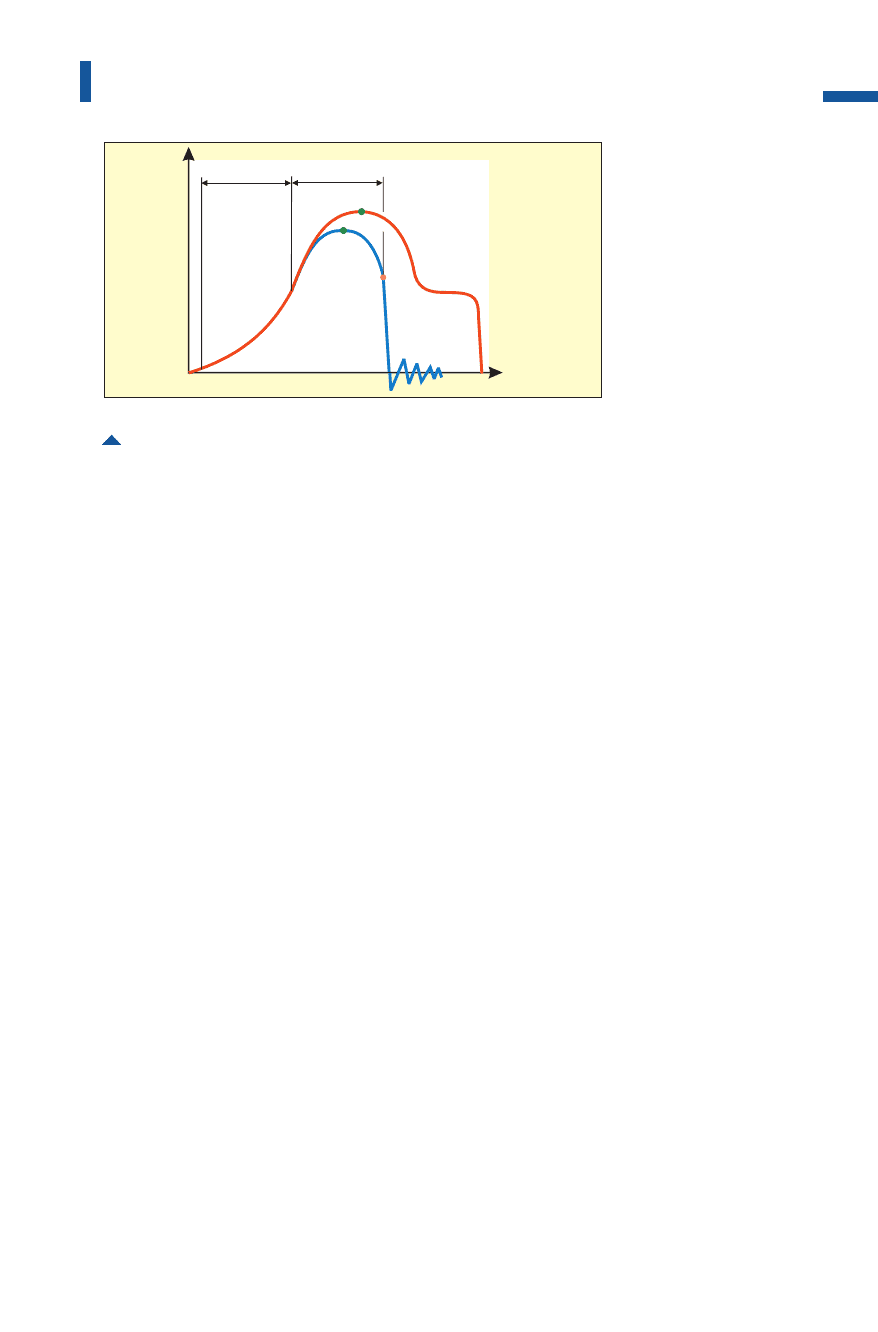
The smooth section of the cut surface and the blanking clearance are
closely related: the greater the blanking clearance, the lower the
smooth cut proportion. In addition to its size, the uniformity of the gap
along the part contour is also important. The gap should remain con-
stant when subjected to load during the blanking operation.
The size of the blanking clearance is primarily determined by the
sheet metal thickness to be cut, but also by the nature and strength of
the workpiece material. In contrast to the blanking clearance occurring
during standard blanking of around 5 to 10% of the sheet metal thick-
ness, the corresponding value for fine blanking lies at around 0.5%
(Fig. 4.7.6).In certain cases, the blanking clearance can also vary over
the part contour. Parts with toothing, for example, are manufactured
with a blanking clearance which is greater in the area of the tooth root
than it is at the tooth tip.
Vee-ring
The vee-ring is a characteristic feature of fine blanking dies. It runs in
the form of a raised serrated jag at a defined distance from the blanking
line and is pressed into the scrap web. Its function is to hold the
punched material outside the blanking line and so prevent lateral flow
of the material during the blanking process. In addition, it serves to
apply compressive stress to the sheet metal, so improving the flow
process.
To simplify maintenance, where sheet metal thicknesses of up to
4.5mm are being processed, the vee-ring is mounted on the pressure
335
Fine blanking
Fig. 4.7.5 Press force-stroke curves for standard and fine blanking
I
II
III
IV
blanking
force
F
s
time[s], stroke[mm]
F
F
s max
Abriß
standard
blanking
fine blanking
Metal Forming Handbook / Schuler (c) Springer-Verlag Berlin Heidelberg 1998
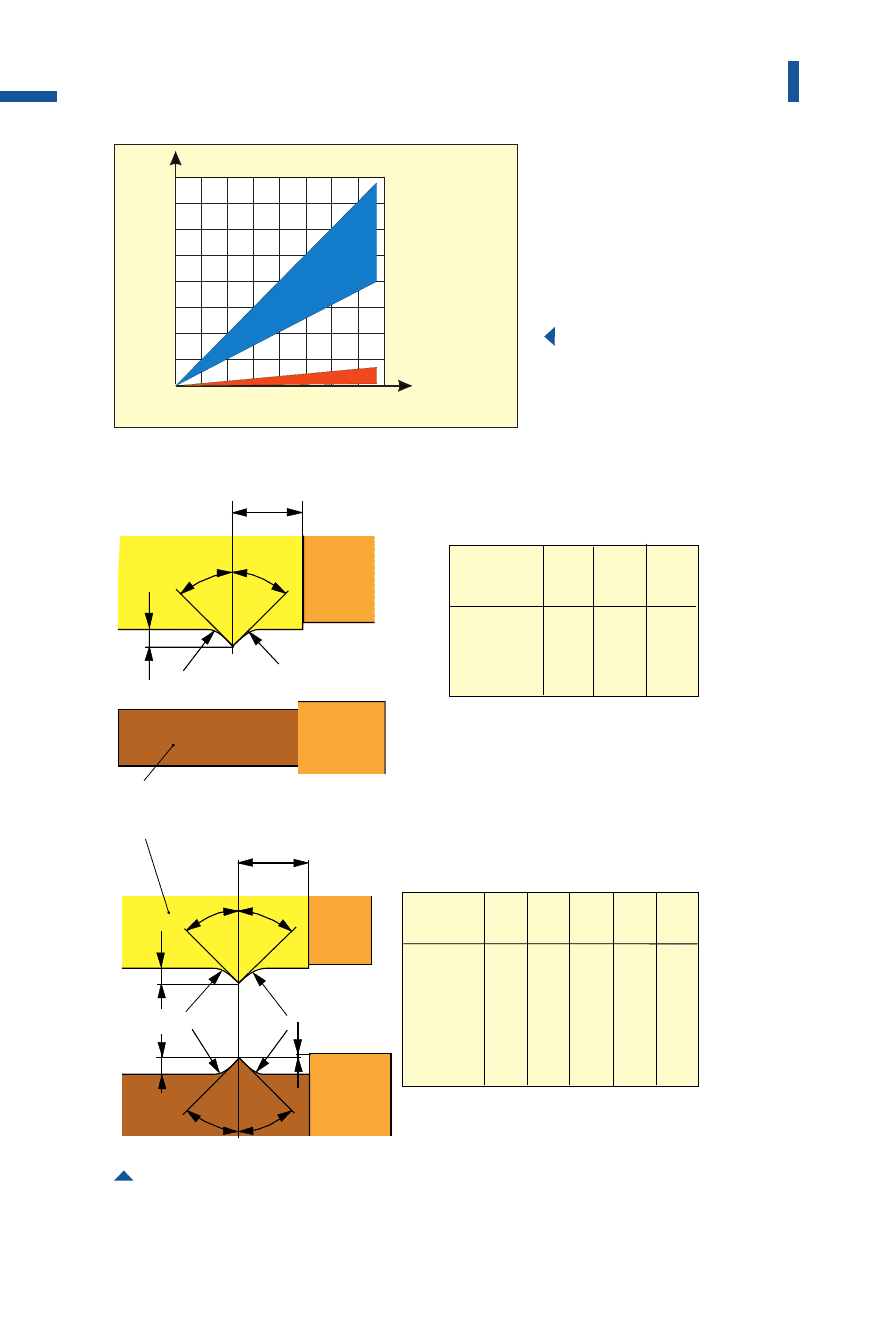
336
Sheet metal forming and blanking
0
0
2 4 6 8 10 12 14 16
0.2
0.4
0.6
0.8
1.0
1.2
1.4
1.6
sheet metal thickness s [mm]
standard
blanking
fine blanking
blank clearance u [mm]
Fig. 4.7.6
Guideline values for the blank-
ing clearances for standard
and fine blanking in function
of sheet metal thickness s
Fig. 4.7.7 Guideline values for vee-ring dimensions
45°
45°
R
R
H
R
A
blanking plate
AH
R
R
2.8 - 3.2 2.5 0.6 0.6
3.3 - 3.7 2.5 0.7 0.7
3.8 - 4.5 2.8 0.8 0.8
[m
m]
[mm] [mm] [mm]
A
r
R
r
R
H
R
h
R
45°
45°
45°
45°
0.1mm
4.5 - 5.5 2.5 0.8 0.8 0.5 0.2
5.6 - 7.0 3.0 1.0 1.0 0.7 0.2
7.1 - 9.0 3.5 1.2 1.2 0.8 0.2
9.1 - 11 4.5 1.5 1.5 1.0 0.5
11.1 - 13 5.5 1.8 2.0 1.2 0.5
13.1 - 15 7.0 2.2 3.0 1.6 0.5
AH
R
Rh
R
r
sheet metal
thickness
sheet metal
thickness
.
[mm][mm] [mm] [mm] [mm] [mm]
vee-ring plate
Metal Forming Handbook / Schuler (c) Springer-Verlag Berlin Heidelberg 1998
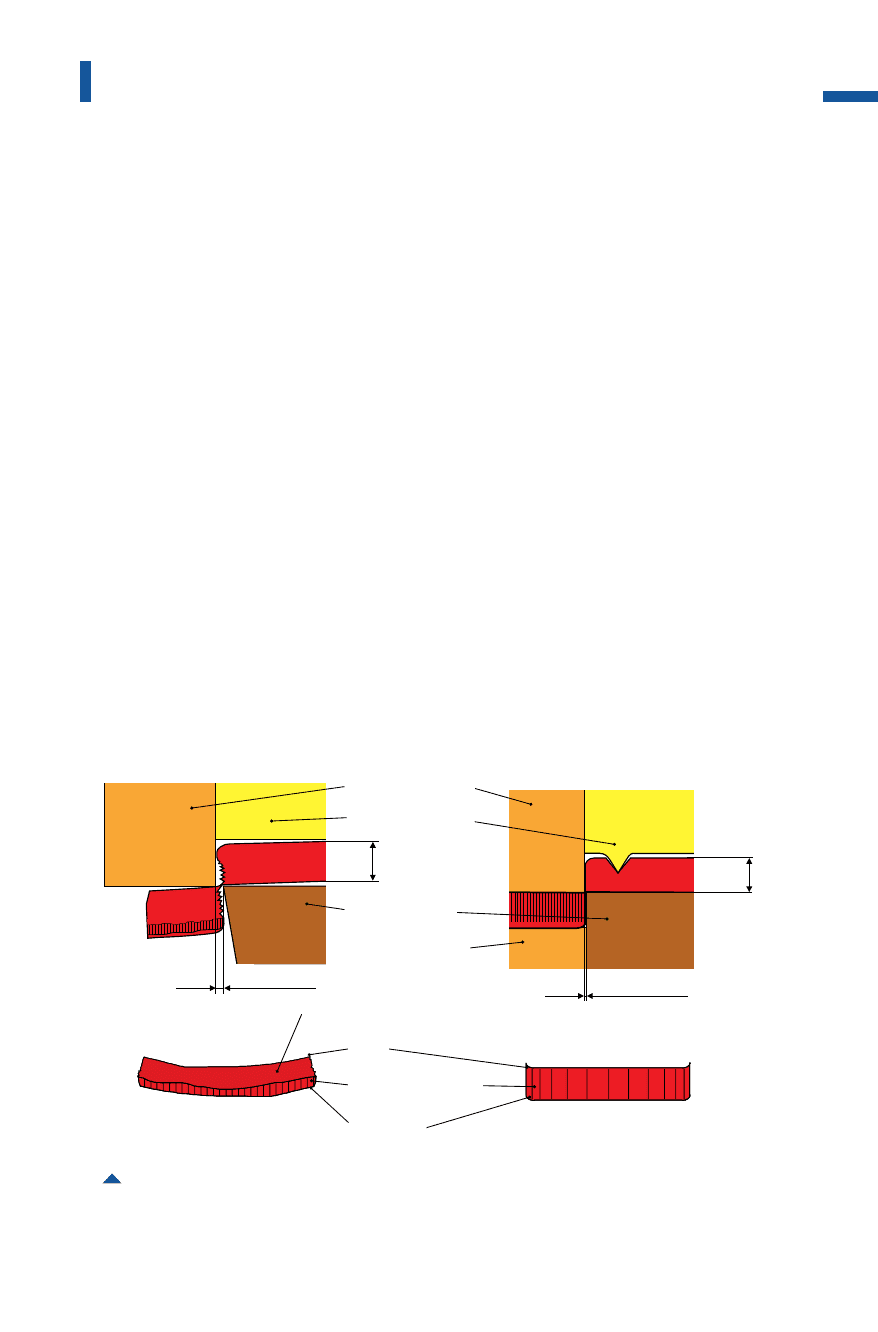
plate of the die, while for thicker materials a second vee-ring is required
on the blanking plate. Where the inner forms are particularly large, the
ejector also features a vee-ring, which is pressed into the inner form slugs
inside the blanking line. Depending on the thickness and shape of the
part, the vee-ring is being increasingly placed on the die plate. In indi-
vidual cases, fine blanking also takes place without the use of a vee-ring.
The dimensions of the vee-ring and the distance from the blanking
edge depend on the thickness of the sheet metal (Fig.4.7.7).In some
cases, vee-rings are mounted only partly in the die area where a smooth
cut is required for functional reasons.
Work result
Generally, normal blanked parts feature a smooth and a fractured cut sur-
face (Fig.4.7.8).The proportion of the smooth portion relative to the
fractured surface depends on a wide number of different influencing vari-
ables, with for example as little as
1
/
4
smooth to
3
/
4
fractured surface. The
smooth area features the die-roll, while on the opposite side is the blank-
ing burr (cf.Sect.4.5). The flatness and dimensional tolerances of the
standard blanked part are inferior. The fine blanked surface, in contrast,
is tear and fracture-free over the entire thickness of the sheet metal and
337
Fine blanking
Fig. 4.7.8 Work result for standard blanking
(left)
and fine blanking
(right)
s
s
burr
fracture zone
blanking punch
vee-ring plate
blanking plate
ejector
smooth cut zone
die-roll
u ~ 5 % s
u ~ 0,5 % s
Metal Forming Handbook / Schuler (c) Springer-Verlag Berlin Heidelberg 1998

Steel group Group Abbreviation Material no.
as per DIN as per EURO standard
soft, unalloyed steels
hot strip 1614 StW22 1.0332 FeP11 EN111
metal sheet 1623 St14 1.0338 FeP04 EN10130
cold strip 1624 St4 1.0338
general structural steels
17 100 St37-3N 1.0116 Fe360D1 EN10025
St44-3N 1.0144 Fe430D1 EN10025
fine-grain structural steels
17 102 StE420 1.8902 S420N EN10113-2
StE460 1.8905 P460N EN10028-3
case hardening steels
17 210 Ck15 1.1141
16MnCr5 1.7131
heat-treatable steels
17 221 Ck45 1.1191 2C45 EN10083-1
17 222 41Cr4 1.7035 41Cr4 EN10083-1
17 200 42CrMo4 1.7223 42CrMo4 EN10083-1
tool steels
17 350 100Cr6 1.2067
C85W 1.1830
stainless steels
17 440
ferritic X6Cr13 1.4000
X30Cr13 1.4028
austenitic X5CrNi18.10 1.4301
Aluminium and aluminium alloys Copper and copper alloys
Abbreviation Material no. as per DIN Abbreviation Material no. as per DIN
AlMg3 3.3535 1745 CuZn37 2.0321 17670
AlMgSi1 3.2315 1745 CuSn8 2.1030 17670
CuNi25 2.0830 17670
approximately vertical relative to the surface of the sheet metal. The
fine blanked part is also flatter than a standard blanked part.
4.7.2 Fine blanking materials, forces, quality characteristics
and part variety
Material selection
Steel is the most commonly used material in the field of fine blanking
technology. Non-ferrous metals such as copper, aluminium and their
alloys account for no more than 10%, although the tendency to use
these is on the increase. Due to the high proportion of steel materials
used, these are described in greater detail here.
The steel types used are broken down into a number of groups: soft
unalloyed steels, general structural steels, fine-grained structural steels,
338
Sheet metal forming and blanking
Table 4.7.1: Selection of fine blanking materials
Metal Forming Handbook / Schuler (c) Springer-Verlag Berlin Heidelberg 1998
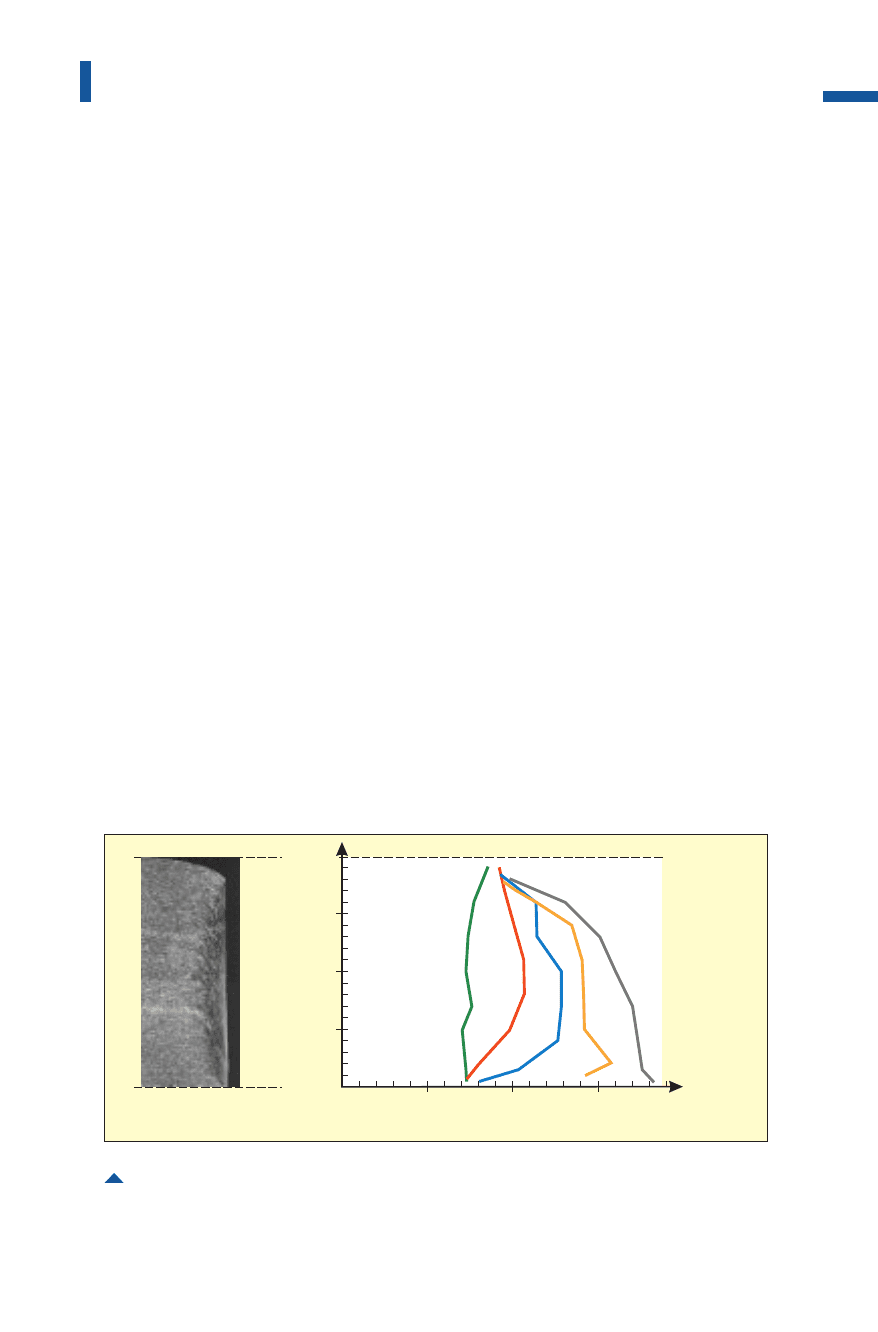
case hardening nitrited steel, heat-treatable steel, tool steel, rust-proof
ferritic steels, rust-proof austenitic steels and special steels (cf. Sect.4.2.2).
These steels can be processed in the form of hot or cold strip or flat bar
steel. Flat products must be free of scale (Table 4.7.1).
Material stress and properties
There is an underlying difference in the material stress which occurs
during fine blanking and standard blanking. This corresponds to a flow
shearing process which is only possible if certain specific material prop-
erties are fulfilled. The grains of the metal microstructure are subjected
to a marked cold forming process by the blanking punch prior to the
point of separation. This grain deformation calls for a formable materi-
al with a high formability, i.e. with a high degree of ultimate elonga-
tion and fracture necking.
The flow processes taking place in the shearing zone and the work
hardening are illustrated in Fig.4.7.9.The cold forming of the grains
increases from the die-roll to the burr side of the part, and decreases
from the cut surface towards the center of the workpiece. At a certain
distance from the surface, the grains which make up the microstructure
are no longer affected by the fine blanking process.
The fine blanking capability of steels is determined on the basis of
their chemical composition, their degree of purity, their microstructure,
their treatment and the prevailing mechanical and technological con-
339
Fine blanking
Fig. 4.7.9 Material flow
(left)
and work hardening
(right)
in the shearing zone
1
2
3
4
0.05mm
0.30mm
0.15mm
distance from cut surface
0.50mm
1.00mm
0 100 200 300 400
hardness[HV 0.2]
die-roll side
burr side
sheet metal
thickness
sheet metal thickness [mm]
Metal Forming Handbook / Schuler (c) Springer-Verlag Berlin Heidelberg 1998
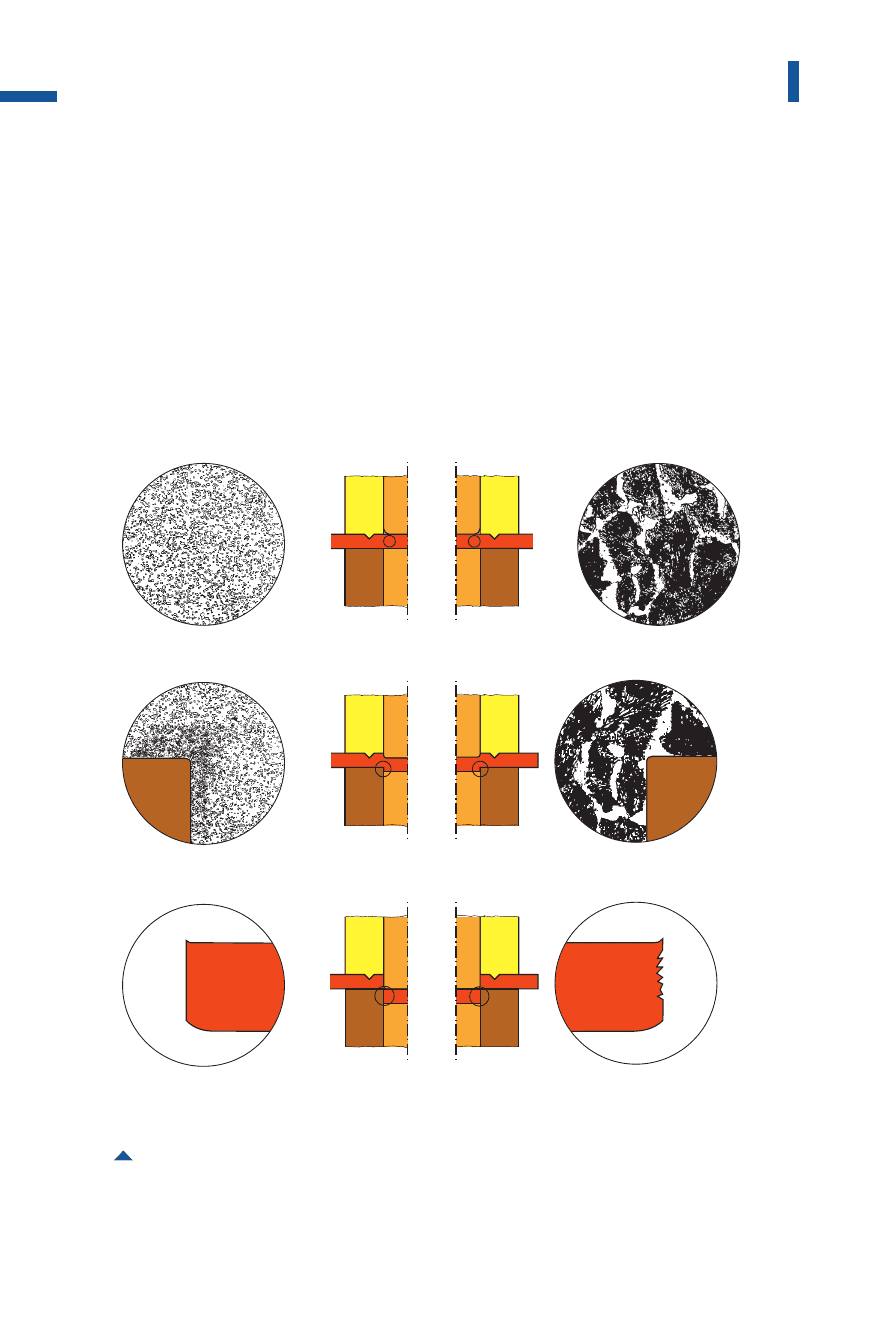
ditions. Starting with soft, unalloyed steels with a low carbon content,
fine blanking capability increases on principle with an increasing pro-
portion of carbon and a higher alloy content. There is no precise limit
based on the content of carbon and alloy materials from which fine
blanking capability can be said not to exist.
The microstructure of a material has a particularly marked influence on
the properties of the cut surface, the dimensional stability of the part and
the service life of dies. The illustration on the top right of Fig. 4.7.10is a
schematic representation of the microstructure of a C45 steel which has
340
Sheet metal forming and blanking
Fig. 4.7.10 Schematic representation of the fine blanking process with a suitable
(left)
and
unsuitable
(right)
material microstructure
microstructuresuitable microstructureunsuitable
blankingprocess blankingprocess
fineblankedsurface,
freeoffractureandtear
fineblankedsurface
withtears
Metal Forming Handbook / Schuler (c) Springer-Verlag Berlin Heidelberg 1998
